What is NetJSON?
NetJSON is a data interchange format based on JavaScript Object Notation (JSON) designed to describe the basic building blocks of layer2 and layer3 networks.
It defines several types of JSON objects and the manner in which they are combined to represent a network:
network configuration of devices
monitoring data
routing information
network topology
NetJSON aims to create an ecosystem of interoperable software that will enable developers to write network-centric applications faster and better. You can find out more about the motivations and goals of NetJSON in “Why NetJSON?”.
Specification
We are putting effort into writing a readable and easy to understand specification, which is the official document explaining NetJSON.
If you want to get a quick overview of what NetJSON can offer read on, but refer to the NetJSON Draft Specification for more detailed information.
DeviceConfiguration
The DeviceConfiguration object aims to describe the network
configuration of a device like a router, a wireless point to point device,
a server, a raspberry pi or whatever is able to send packets through a
computer network.
A simplified DeviceConfiguration example
{
"type": "DeviceConfiguration",
"general": {
"hostname": "RouterA"
},
"interfaces": [
{
"name": "lo0",
"type": "ethernet",
"addresses": [
{
"address": "127.0.0.1",
"mask": 8,
"proto": "static",
"family": "ipv4"
}
]
},
{
"name": "eth0",
"type": "ethernet",
"addresses": [
{
"address": "192.168.1.1",
"mask": 24,
"proto": "static",
"family": "ipv4"
}
]
}
]
}
The previous example describes a device named RouterA which has two
interfaces: the typical loopback interface and an ethernet interface named
eth0 which has a statically assigned ip address 192.168.1.1 and a
network mask of 24 bits (CIDR notation).
DeviceConfiguration specification
For a full specification, please refer to the relevant DeviceConfiguration section in the NetJSON Specification.
DeviceMonitoring
The DeviceMonitoring object aims to describe the status of a network
device, like its uptime, its rx/tx packet count, cpu usage and any other
bit of information that is useful for network monitoring purposes.
A simplified DeviceMonitoring example
{
"type": "DeviceMonitoring",
"general": {
"hostname": "RouterA",
"uptime": 3501937
},
"interfaces": [
{
"name": "lo0",
"uptime": 1404305354,
"statistics": {
"collisions": 0,
"rx_frame_errors": 0,
"tx_compressed": 0,
"multicast": 0,
"rx_length_errors": 0,
"tx_dropped": 0,
"rx_bytes": 9287737,
"rx_missed_errors": 0,
"tx_errors": 0,
"rx_compressed": 0,
"rx_over_errors": 0,
"tx_fifo_errors": 0,
"rx_crc_errors": 0,
"rx_packets": 57624,
"tx_heartbeat_errors": 0,
"rx_dropped": 0,
"tx_aborted_errors": 0,
"tx_packets": 57624,
"rx_errors": 0,
"tx_bytes": 9287737,
"tx_window_errors": 0,
"rx_fifo_errors": 0,
"tx_carrier_errors": 0
}
},
{
"name": "eth0",
"uptime": 1294305354,
"statistics": {
"collisions": 0,
"rx_frame_errors": 0,
"tx_compressed": 0,
"multicast": 0,
"rx_length_errors": 0,
"tx_dropped": 0,
"rx_bytes": 3542783708,
"rx_missed_errors": 0,
"tx_errors": 0,
"rx_compressed": 0,
"rx_over_errors": 0,
"tx_fifo_errors": 0,
"rx_crc_errors": 0,
"rx_packets": 35118502,
"tx_heartbeat_errors": 0,
"rx_dropped": 14,
"tx_aborted_errors": 0,
"tx_packets": 11761973,
"rx_errors": 0,
"tx_bytes": 2952333765,
"tx_window_errors": 0,
"rx_fifo_errors": 0,
"tx_carrier_errors": 0
}
}
]
}
This example refers to the same router shown in the DeviceConfiguration
example shown earlier, but
this time the JSON object contains basic network traffic statistics of the
interfcaes of RouterA: lo0 and eth0.
DeviceMonitoring specification
For a full specification, please refer to the relevant DeviceMonitoring section in the NetJSON Specification.
NetworkRoutes
The NetworkRoutes object aims to describe a list of routes that are
installed in a routing table.
NetworkRoutes allows to represent either dynamic or statifc routes.
A simplified NetworkRoutes example
{
"type": "NetworkRoutes",
"protocol": "olsrv2",
"version": "0.8.2",
"revision": "v0.8.2-6-ge2e3acc",
"metric": "ff_dat_metric",
"router_id": "192.168.0.101",
"routes": [
{
"destination": "192.168.0.102",
"next": "169.254.1.102",
"cost": 4292352,
"device": "eth1"
}
]
}
This example shows a list of routes installed in a router. The network in this example is very small because the routing table contains only one route. In this example the routes are managed by the olsrd2 routing deamon.
NetworkRoutes specification
For a full specification, please refer to the relevant NetworkRoutes section in the NetJSON Specification.
NetworkGraph
The NetworkGraph object aims to describe the topology of a network and
it’s comprised of a list of nodes and a list of links between nodes.
It’s main goal is to allow to visualize and monitor links between nodes in a network (eg: understanding when a link fails), but implementations for distance vector routing protocols are allowed to return a partial view of the network which can be used by a collector to build the full graph.
A simplified NetworkGraph example
{
"type": "NetworkGraph",
"protocol": "olsr",
"version": "0.6.6",
"revision": "5031a799fcbe17f61d57e387bc3806de",
"metric": "etx",
"router_id": "172.16.40.24",
"label": "Test Network",
"nodes": [
{
"id": "172.16.40.24",
"label": "node A",
"properties": {
"hostname": "node1.my.net"
}
},
{
"id": "172.16.40.60",
"label": "node B",
"properties": {
"hostname": "node2.my.net"
}
},
{
"id": "172.16.41.1",
"label": "node C",
"properties": {
"hostname": "node3.my.net"
}
}
],
"links": [
{
"source": "172.16.40.24",
"target": "172.16.40.60",
"cost": 1.000
},
{
"source": "172.16.40.24",
"target": "172.16.41.1",
"cost": 1.000
},
{
"source": "172.16.40.60",
"target": "172.16.41.1",
"cost": 1.000
}
]
}
This example shows a small mesh network of 3 nodes which are connected in full mesh.
When processed with one of the existing implementations
(openwisp-network-topology), the previous
NetworkGraph object results in the following image:

NetworkGraph specification
For a full specification, please refer to the relevant NetworkGraph section in the NetJSON Specification.
NetworkCollection
The NetworkCollection object is a wrapper that can be used to list
several NetJSON objects in a single JSON object.
A simplified NetworkCollection example
{
"type": "NetworkCollection",
"collection": [
{
"type": "DeviceConfiguration",
"general": {
"hostname": "RouterA"
},
"interfaces": [
{
"name": "eth0",
"type": "ethernet",
"addresses": [
{
"address": "192.168.1.1",
"mask": 24,
"proto": "static",
"family": "ipv4"
}
]
}
]
},
{
"type": "DeviceConfiguration",
"general": {
"hostname": "RouterB"
},
"interfaces": [
{
"name": "eth0",
"type": "ethernet",
"addresses": [
{
"address": "192.168.1.2",
"mask": 24,
"proto": "static",
"family": "ipv4"
}
]
}
]
}
]
}
In this two DeviceConfiguration objects are grouped in a single
NetworkCollection object that acts as a list of configurations.
NetworkCollection specification
For a full specification, please refer to the relevant NetworkCollection section in the NetJSON Specification.